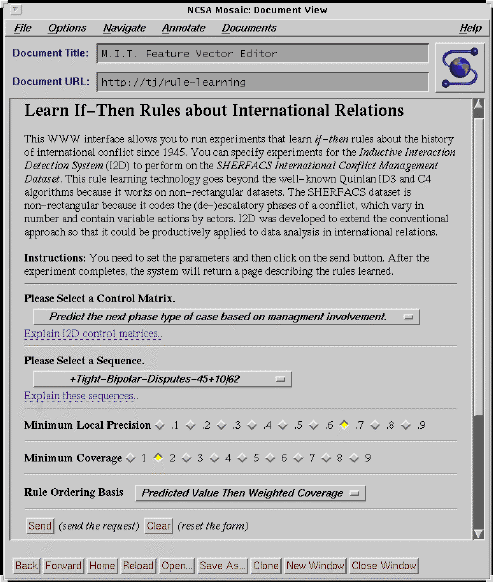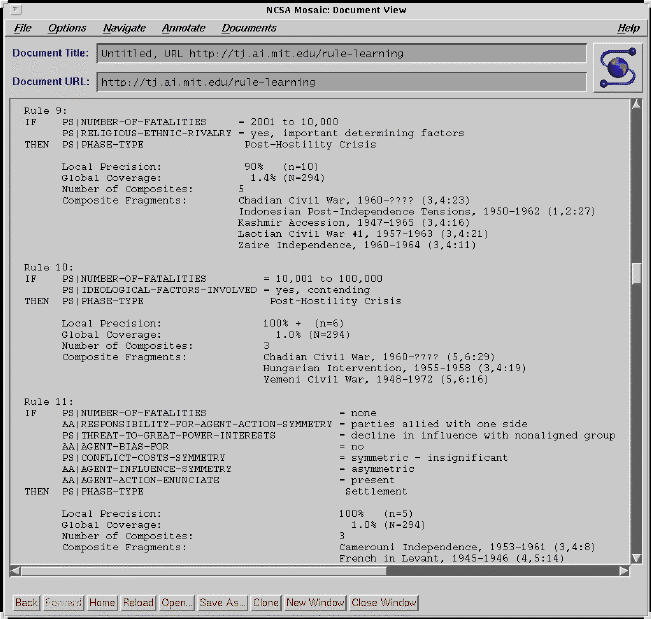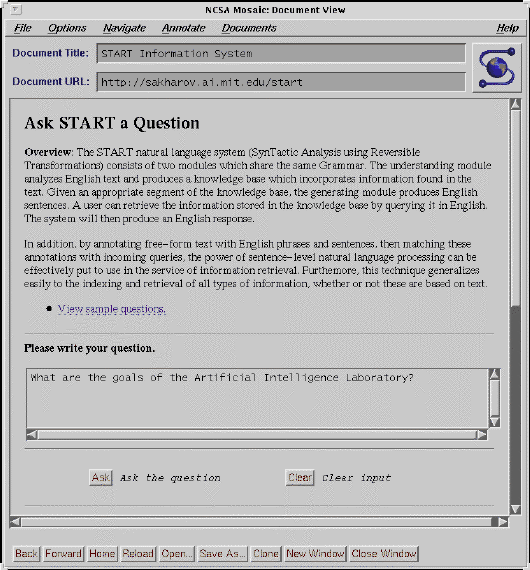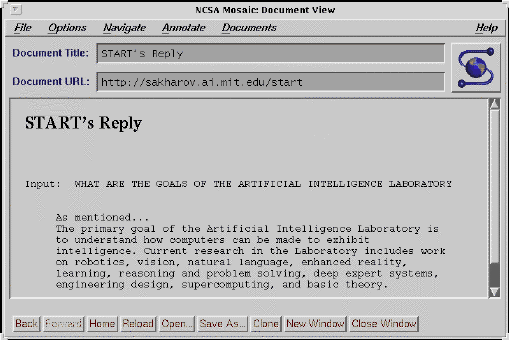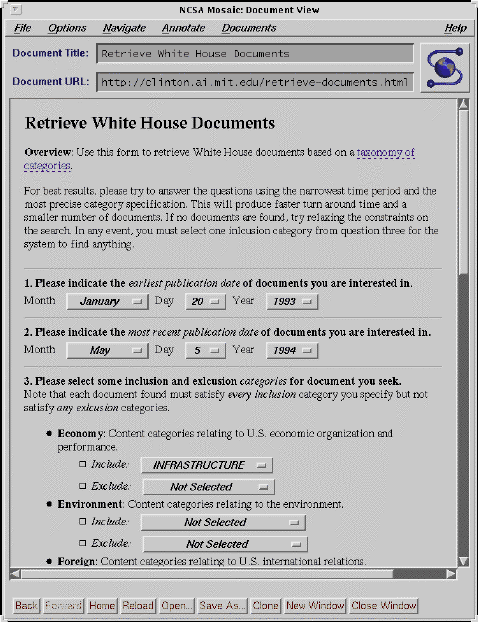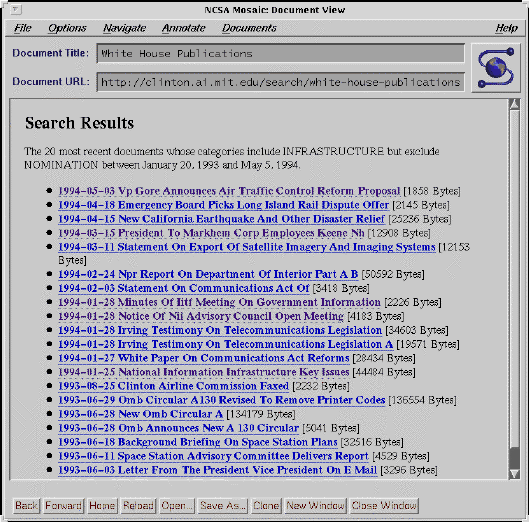- Overview
- Introduction
A World-Wide Web (WWW) server was implemented in Common LISP (see the
FAQs, the Association
of Lisp Users and the
ANSI specification) in order to facilitate exploratory programming in the
interactive hypermedia domain and to provide access to complex research
systems over the Web. The general motivation for developing this server was
to provide a computational tool that would strengthen the link between the artificial intelligence
researchers and the distributed
hypermedia community. As the amount of information available over the
World-Wide Web grows, it will become increasingly necessary to deploy
intelligent methods to store, retrieve, analyze, filter, and present
information. At the same time, high-productivity programming tools employed by
AI researchers will become increasingly relevant for testing new ideas in
servers before incorporating them into standards-based clients. A Common LISP
HTTP
server provides a bridge that allows AI researchers to plug their systems into
the WWW as it affords developers of distributed hypermedia standards a vehicle
through which they can import effective and relevant technologies. In this
spirit, the conclusion proposes that HTML+ borrow
ideas from the CLIM Presentation System in order to
modernize the user interfaces in clients, to upgrade the interaction paradigm,
and to achieve a number of efficiency gains for servers.
More specific motivations for this work in the context of the Intelligent
Information Infrastructure Project at M.I.T. were to develop an HTTP
server meeting these criteria:
- High-Productivity Programming: Since all of our research systems
are programmed in Common LISP and are incrementally extensible to meet
research requirements, the server should be fully accessible from LISP and
able to evolve at the same pace.
- Multiple Transport Media: We wanted to generalize our existing
technology, and so, to develop a specification and control framework that
works seamlessly over email and HTTP.
- Automatic Form-Processing: Since we already had an automatic
form-processing substrate developed in an email
server application, the server should be able to apply the same technology
over the Web.
- Dynamic HTML+ Generation: Since our research emphasizes
tailoring output to meet user requirements, we needed HTML+ operators that our
research systems could use to generate HTML dynamically.
The current server is excellent for rapid-prototyping precisely because it
builds on Common LISP and provides a fine-grained
vocabulary of operators which are easily combined and modified according to
evolving application requirements and draft protocol standards. The server
itself is an example of rapid prototyping as its 2700 lines of LISP were
written from scratch and debugged by one person in about two weeks. A high-profile demonstration at the end of the
period was well-received.
More recently, an authoring tool for email-based forms was generalized to emit
HTML+ (Renaud, 1994). This graphical tool is now
used to author forms that can work over email and WWW. The authoring tool is
important for the generalization of email forms across the Web because form
processing in email servers performs automatic retries when user input is
syntactically or semantically incorrect. To implement automatic retries over
the WWW, it is necessary to dynamically generate retry forms to explain the
problem, incorporate all correct answers from the original form, and allow the
user to correct the erroneous answers. Computing form retries requires
datastructures beyond those normally associated with scripting languages.
[Other research ( Houh,
Lindblad, & Wetherall, 1994) arrives at similar conclusions concerning the
limitations of scripting languages for more advanced, dynamic WWW
applications.] In general, more advanced form-based applications
will need the richer datastructures offered by full-featured programming
languages like Common LISP.
- Initial Applications
The Common LISP HTTP Server implementation was driven initially by the
desire to provide WWW access to email servers and associated document or
survey databases, which were built on the COMLINK
System. Development of a native server offered WWW access not just for
these specific applications, but also, for the COMLINK substrate systems in
general. Thus, any application developed on top of COMLINK would automatically
have the World-Wide Web as a user interface.
The initial applications included:
- Document Search: Retrieve government documents via a the taxonomy of
categories used to distribute them over email (see search
index and form interfaces).
- Standing Search URLs: Find the latest, topically-focused
documents with convenient anchors that prespecify criteria for dynamic
searches (see publications for example).
- Public Access Email: Send correspondence to elected government
officials through a forms interface to an
email server.
- Electronic Publications: Subscribe to electronic publications
through a forms
interface to an email server.
All these applications handle invalid or incoherent user input by returning
dynamically generated HTML+ that explains the problem and guides the user's
efforts to resubmit.
- Advanced Applications
Two artificial intelligence applications were fielded by the end of the
development period:
Integration with both of these large LISP systems was possible within several
of hours of work each.
- Server Features
The main implemented features of the server include:
- All Major Content Types Served: The server not only handles text
and HTML but also serves images (xbitmap, gif, jpeg), audio, video (mpeg), and
application (postscript).
- Major Methods Handled: The server fully supports the GET and
HEAD operations, and handles the POST method to receive user values in form
processing.
- Object-Oriented Implementation: The Common LISP
Object System (CLOS) is used to implement key server components. This
allows modular programming based on generic operations defined on URL and
server object.
- Typed Condition Handling: The Common LISP condition system is
used to signal various conditions, or errors, that may occur. Condition
classes are defined for all HTTP response codes and are arranged
hierarchically. When most conditions are signalled, execution transfers to a
handler at the top-level of the server. This handler applies a generic
response function to the condition object that transmits the appropriate
response code to the client. Conditions can specialize their method for the
response function in order to customize behavior.
- HTML+ Authoring Functions: A series of functions and macros
provide a vocabulary of HTML+ operations, at least as complete as support of
HTML+ by reference clients. (See the example
code.) The authoring functions serve a number of purposes:
- Defined Interface: Provide a functional interface for generating
HTML+ under program control, whether on the fly to respond to a user or batch
to write static files.
- More Compact Vocabulary: Quite often authoring abstractions
condense a range of HTML+ tags into a single parameterized function. For
example, an enumeration macro and a text style macro span the various
available tags. (See the example code.)
- Input Types: Tags for HTML+ input fields were consolidated in an
abstraction analogous to CLIM presentation types.
Implemented as CLOS classes, input types support
generic methods for accepting input from the user by writing the
appropriate HTML+ tags during form creation and interpreting returns during
form submission. A single set of arguments for the generic function
standardizes parameters across all input types (audio, date, float, image,
integer-range, multi-line-text, multiple-choice, radio-button, reset-button,
select-choices, string, submit-button, url).
- Query Abstraction: The query abstraction from COMLINK is imposed on HTML+/HTTP form processing to
facilitate asking the user atomic questions and responding to user answers.
Although it simplifies accepting single-valued input types, the query concept
has an even bigger impact for input types returning multiple values: Here,
the input type system takes care to reintegrate what HTML+ treats as
separate queries into a single sequence-valued return. This
conserves code abstraction by preventing every response
function for a form from having to reinvent the same program cliche.
- Smooth Code Evolution: An abstraction layer separates code that
generates HTML+ from the raw tags. This allows the authoring functions to be
updated when the underlying specification changes, and thereby obviating the
need to update any calling functions.
- Network Security: The server implements subnet security based on
client IP address.
- Classes of HTTP URLs
Uniform Resource Locators are implemented as CLOS
objects, to which URL strings are mapped upon receipt. Although the URL
implementation handles all URL schemes defined by the URL
specification, only the base classes for HTTP scheme will be described
here:
- Path URLs are analogous to a directory in a file system because
they contain no specific URL name and extension type. These can map to a
physical file if desired, or just to a directory hierarchy.
- Object URLs are specific documents with a name and usually an
extension that indicates the kind of data available in the URL.
- Search URLs specify searches for particular databases and may
have an associated HTML document that describes the search. Parameterized export types are defined for kinds of database
interfaced.
- Form URLs are just like an object URL with
extension HTML, except that they take a response function to be called
whenever a client submits (POSTs) form values.
- Computed URLs are much like form URLs except that they fully
compute their response to a GET operation. (See the example code.)
- Exporting URLs
URLs become accessible via the server once they have been exported with
the EXPORT function. The export function always takes an external URL name
and a export type, which defines the computation used to serve the data
denoted by the URL. In most cases, some additional arguments are provided,
depending on export type. For example, when data resides in a file, the
physical pathname where the data is stored is passed as an argument to export.
Similarly, when a database is searched, the database is passed as an export
argument along with the URL. The following export types are defined:
- Text Types: Text-File, HTML-File, LISP-File, Text-Directory
(computes a display of links to substructure), LISP-Directory,
HTML-Form, HTML-Computed.
- Other Types: X-Bitmap-Image, GIF-Image, JPEG-Image, Basic-Audio,
MPEG-Video, Postscript-File.
- Redirect: When a URL has moved to another host, the server
signals an HTTP redirect that tells the client where to find the document.
- Computed URL Example
In this example, the client receives an HTML+ page that the server
computes by listing a remote directory and repackaging the file names in a friendlier format.
Below, we see the Common LISP definition for the response function that is
invoked when a client sends the server a GET for the computed URL.
;; Export the computed URL and provide its response function.
(export-url "http://clinton.ai.mit.edu/radio-addresses.html"
:html-computed
#'compute-clinton-audio-page)
;; Writes HTML+ directly to the client over STREAM, which is a live
;; HTTP connection to the client.
(defmethod compute-clinton-audio-page ((url url:http-computed-url) stream)
(flet ;; Abstract the internal function that writes an entry.
((write-pathname (pathname stream)
(let ((url (url:pathname-ftp-url-string pathname))
(friendly-date (uu-radio-address-anchor-date pathname)))
(when friendly-date
;; Encapsulate text within an enumeration entry.
(html+:enumerating-item (stream)
;; Change the text style to bold.
(html+:with-rendition (:bold :stream stream)
;; Write an HTML+ anchor spec using the friendly name.
(html+:note-anchor
friendly-date :reference url :stream stream)))))))
;; Main body of method.
(let ((directory-list (www-utils:ftp-directory-info
*saturday-radio-addresses-audio-directory*
"anonymous"
(www-utils:user-mail-address))))
(if directory-list
;; Inform the client that we're winning and returning HTML+.
(with-successful-response (stream :html)
;; Provide the header info that goes in the HTML+.
(html+:with-document-preamble (:stream stream)
(html+:declare-base-reference url :stream stream)
(html+:declare-title "Saturday Radio Addresses" :stream stream))
;; Use the body environment.
(html+:with-document-body (:stream stream)
(html+:with-section-heading
((html+:image
"http://clinton.ai.mit.edu/icons/sound-icon.xbm"
"The President's Saturday Radio Addresses to the Nation"
:stream nil))
(html+:new-paragraph :stream stream)
;; Provide the instructions for the WWW page.
(write-string "By clicking on a date, you can listen to
the audio for a Saturday radio address
by President Clinton." stream)
(html+:horizontal-line :stream stream)
(html+:new-paragraph :stream stream)
;; Enter an environment for enumerating items.
(html+:with-enumeration (stream :itemize)
;; Map over files and write them as bullets.
(loop for (pathname) in directory-list
do (write-pathname pathname stream))))))
;; Signal that the server cannot connect to the remote host.
(error "Unable to connect to UU.NET to get file list.")))))
- Common LISP
The HTTP server is written in Common LISP (see Winston and Horn (1989), Steele (1990), the
FAQs, the Association
of Lisp Users and the
Draft ANSI specification) to provide a user-extensible environment for
interactive multimedia over WWW. Because the goal is to develop a
fine-grained vocabulary of operators that programs and software developers
share, Common LISP is one of the best choices available today. Once operators
are abstracted, programs and users call them, instead of (re-)writing them
again. This fine-grained abstraction yields high productivity because:
- No Code Duplication: No effort is wasted writing again code that
already exists because programs are shared at a very fine level of abstraction
(e.g., individual functions, variables).
- Code Evolution: Well abstracted code is easily evolved as
protocols or requirements change.
- Dynamic Linking: Incremental compilation speeds development of
large programs and facilitates evolutionary programming.
- Powerful Abstractions: Function-compositional languages, such
as Common LISP, allow, and even encourage, programmers to build up a
vocabulary of high-level operators that are recycled to solve similar domain
problems. Indeed, writing an application becomes a process of developing a
vocabulary of operators to specify the desired functional
process.[See Abelson and Sussman
(1985) for a detailed introduction to abstraction in a functional
language.]
A high productivity environment reduces the work required to develop
new packages and makes most efficient use of the scarce time of scientists.
Generalizing the individual case to a community of researchers, sharing this
kind of environment and each other's extensions maximizes the rate at which
the community searches mechanism space for problem solutions. Moreover,
well-abstracted code joins with self-documenting capabilities in the HTTP
server to make it an effective pedagogical environment; everything is readily
available for inspection, modification, and experimentation.
- The Common LISP Object System
Common LISP embeds a native object-oriented programming language, the
Common LISP Object System (CLOS). All significant datastructures in the HTTP
server are implemented as CLOS objects (Bobrow et
al., 1988; Keene, 1989). CLOS distinguishes
classes and instance objects. The behavior of instance objects is defined by
associated classes, which can inherit functionality and state variables from
multiple superior classes. Instances can have local state, held by instance
variables, and they can have methods, or operations, which they support.
Generic operations constitute a protocol that instances of different classes
all support with their own, possibly different methods. CLOS supports
multimethods that can dispatch based on the types of multiple
arguments. A pervasive object-oriented implementation helps enforce
abstraction and modularity as it enhances flexibility and code sharing.
- The Common LISP Interface Manager
Modern Common LISP provides a high-level window system tool, the Common
LISP Interface Manager (CLIM) (see the
specification, (Rao, et al,
1991). Written in Common LISP, CLIM runs on a variety of workstations,
implementing its machine-independent abstractions with native window systems
and mimicking their look and feel. By introducing high-level
abstractions for specifying window interfaces, CLIM makes it easier and
quicker to define window interfaces. Instead of requiring many months,
sophisticated user interfaces can be written in several days.
Beyond general window system abstractions, the automatic form processing in
COMLINK forms relies heavily on an important CLIM
abstraction: the presentation system controls how the user specifies or
perceives arbitrary LISP objects. Each presentation type has a method
to present (display) an object on the computer screen, and a method to
accept (receive input) an object from the user, whether via the
keyboard, the mouse, or other input device.
In general, presentation types specialize built-in or constructed LISP
types. Presentation translators can be defined to convert from the
LISP object associated with one presentation type to another. The combination
of type subsumption and presentation translation allows CLIM to resolve
equivalences, and thus, accept input more intelligently.
The present and accept methods are like little generators and parsers
specialized to a presentation type. They can perform a simple operation, such
as accepting an integer between 1 and 10, or they can execute a very complex
computation. For example, in one research system (Mallery, 1991), nodes in semantic network
representing natural language text can be presented through a sentence
generator so that the user sees them as generated sentences or sentence
fragments. Similarly, sentences or paragraphs can be accepted via a
presentation type that calls a full natural language system to parse and
represent the text. Thus, present and accept methods execute LISP code that
can perform an arbitrary translation between what the user sees or what the
user inputs and the internal datastructures manipulated by programs.
Once defined, these presentation types mediate all data entry and display,
and thus, users perceive only the external, user-friendly representation, and
never with the internal representation. Such dynamic, bidirectional
translation allows users to directly manipulate program data (viewing
it in translated form) and actually simplifies the program model presented to
the user.
- The COMLINK System
Over the past year and a half, the author developed a system that performs
sophisticated operations over email, routes documents, and automatically
surveys users. The COMLINK system uses a transaction-controlled,
persistent-object database to represent users, hosts, mailing lists, document
categories, documents, and more. For the purposes of this paper, three
aspects of this system are relevant.
Document Routing and Retrieval
The COMLINK system supports document universes with associated
taxonomies of categories. As documents are distributed through document
universes, they are archived and indexed by some categories. Users can
subscribe to a publications stream or retrieve documents by means of boolean
combinations of categories. When retrieving documents, users may also provide
temporal and quantity constraints to further circumscribe the documents found.
The document retrieval and publication code that stands behind the initial WWW applications uses this technology
as a back-end.
Automatic Form Processing
The COMLINK system interacts with users via textual forms exchanged in
email, as well as conventional ``subject line'' commands, much like those
found in standard listservers. Email servers are associated with a command
interface that provides access to all the forms and subject line commands.
Forms are composed of a series of queries. In addition to a
question or instructions, a query has an associated CLIM presentation type that presents any
default value and parses any new value supplied by the user. Forms are
written to a stream by calling the WRITE-FORM function with a set of value
bindings for each query of the form. As WRITE-FORM calls the generic operation
to present each query, the queries present themselves by calling the PRESENT
method for their presentation type.
Forms are parsed by finding queries and converting the textual input
associated with each query into its internal representation. The basic
procedure for parsing a query is:
- Scan
: Locate the query between special delimiters.
- Intern
: Convert the query name into the query object associated with
the form.
- Accept
: Parse the textual representation that follows the
delimited query name by calling the interned query's accept method, which in
turn calls the accept method for the associated presentation type.
- Handle Errors
: If the query value fails to conform to
requirements of the presentation type, signal the condition so that the user
can be asked to respecify failing queries. Typed error objects carry the
information needed to provide the user with user-friendly explanations about
what was wrong and how to correct it.
When query values are successfully parsed, the form's response function is
applied to the parsed query values to perform the computation associated with
the form. If there are query parsing errors, the system returns to the user a
form with all the correct values defaulted and an explanation about how to
correct the failing queries for successful resubmission.
Graphical Form Authoring Tool
A graphical form authoring tool was written by Renaud (1994) for the COMLINK system. Coded in CLIM, the
interface defines meta-level abstractions for forms, queries, and presentation
types that allow users to define automatic surveys and forms without having to
write LISP code. At the same time, the data structures are abstracted in a
way that forms can be defined dynamically under program control. For the set
of presentation types previously defined for COMLINK, Renaud defined new
presentation and accept multimethods that dispatch on the
HTML+ presentation view. This means that the same presentation type,
which already worked for the email view, could now operate for the
HTML+ view, displaying itself in HTML+ and accepting its input with the
HTML+ form-processing facilities.
Unlike HTML+ form input types, CLIM has a rich basic set of presentation
types, which are routinely extended by application programs. After
pairing up the presentation types that match between CLIM and HTML+ form input
types, Renaud defined the appropriate cliches to accept input from the user
for CLIM presentation types via HTML+ cliches. Once this small correspondence
set was exhausted, the rest of the task reduced to accepting a text string
from the client and applying the CLIM accept method to parse the input from
the string. Unfortunately, all the computation required to parse input
strings must remain on the server because there is currently no defined
way to tell clients how to accept the input or check its validity.
- Conclusions
An immediate goal for the Common LISP server is to develop seamless form
processing over both email and the Web. At first, CLIM presentation types
will be evaluated by the server as it checks the values returned in HTML+
forms for validity and parses them into the appropriate internal
representations. After a period of experimentation, during which a good set of
presentation types will be identified, it should be possible to propose a set
of presentation types that clients can handle without undue difficulty. If
servers could transfer definitions to clients, the presentation types
available to remote applications could be extended or refreshed dynamically.
This would require extensions to the HTTP protocol and agreement on a safe
language(s) for transferring presentation parsers and generators to clients.
By relocating the main responsibility for validating user input, considerable
computational load and unnecessary connections can be offloaded from servers
and distributed among clients.
The Common LISP HTTP server makes it possible to interface complex LISP
systems often found in artificial intelligence applications to the World-Wide
Web. Although the immediate goal of the server was to serve as a research tool
for a project on intelligent information routing at M.I.T., the server can be
useful for many other members of the world-wide LISP community and allow them
to participate in the explosion of interesting WWW applications. At the same
time, the rapid prototyping features of Common LISP can now become available
to the WWW research community so that they can more quickly mock up and test
out new ideas.
- Availability
The server home page at
http://www.ai.mit.edu/projects/iiip/doc/cl-http/home-page.html explains
how to obtain copies of the server and provides further information, including
source access.
- Acknowledgments
This paper and the server was improved by comments from Marc Andreessen, Mark
Nahabedian, Benjamin Renaud, Howard Shrobe, and Robert Thau. Benjamin Renaud
implemented the WWW interface to the rule learning system. Boris Katz adapted
his natural language system to allow WWW access. This paper describes research
done at the Artificial Intelligence Laboratory of the Massachusetts Institute
of Technology. Support for the M.I.T. Artificial Intelligence Laboratory's
artificial intelligence research is provided in part by the Advanced Research Projects Agency of the
Department of Defense under contract number MDA972-93-1-003N7.
- References
Abelson, H. and G. J. Sussman, The
Structure and Interpretation of Computer Programs, Cambridge: M.I.T.
Press, 1985.
Bobrow, D., et al., ``A Common LISP Object
System Specification: X3J13 Document 88-002R,'' SIGPLAN Notices, 23,
September, 1988.
Houh, H.,
Lindblad, C. & Wetherall, D., ``Active Pages: Intelligent Nodes on the World
Wide Web,'' Proceedings of the First International Conference on the
World-Wide Web, Geneva: CERN, 1994.
Katz, B., ``Using English for Indexing and Retrieving,''
in Artificial Intelligence at M.I.T.: Expanding Frontiers, edited by P. H.
Winston with S. A. Shellard, Cambridge: M.I.T. Press, vol. 1, ch. 6, 1990.
Katz, B., ``Using Natural Language Annotations in the
Voyager Information System,'' International Aerospace Congress IAC'94,
Moscow, Russia, 1994.
Mallery,
J. C., ``Beyond Correlation: Bringing Artificial Intelligence to Event Data,''
International Interactions, forthcoming, 1994. Postscript.
Mallery,
J. C., ``Beyond Correlation: Bringing Artificial Intelligence to Event Data,''
International Interactions, forthcoming, 1994.
Keene, S. E., Object-Oriented Programming in Common
LISP: A Programmer's Guide to CLOS, Reading: Addison-Wesley, 1989.
Renaud, B., Global Data Sharing and Analysis:
A Networked Hypermedia Approach, Cambridge: Political Science Department,
Massachusetts Institute of Technology, S.B. Thesis, May 1994.
Rao, R., York, W. M., and Doughty, D., ``A
Guided Tour of the Common LISP Interface Manager,'' LISP Pointers,
4(1991).
Steele, G. L., Common LISP: The Language,
Bedford: Digital Press, 1990.
Winston, P. H., and Horn, B. K. P. H.,
LISP, Reading: Addison-Wesley, 1989. This is a good introduction to
Common LISP with special reference to artificial intelligence.
Unseld, S., and Mallery, J. C., ``Interaction
Detection in Complex Datamodels,'' Cambridge: M.I.T. A.I. Laboratory Memo
1298, November, 1991.
- Screen Snapshots

